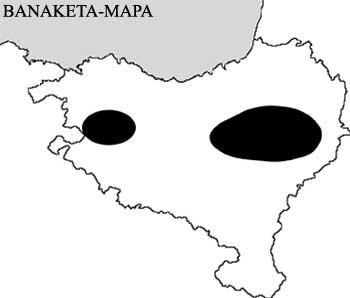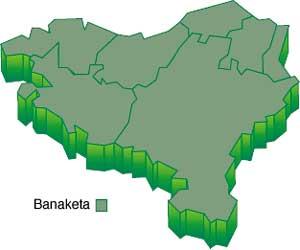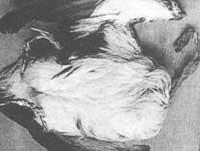The Zabal, lady dressed in the most beautiful skin
1995/01/01 Elosegi Irurtia, Migel M. Iturria: Elhuyar aldizkaria
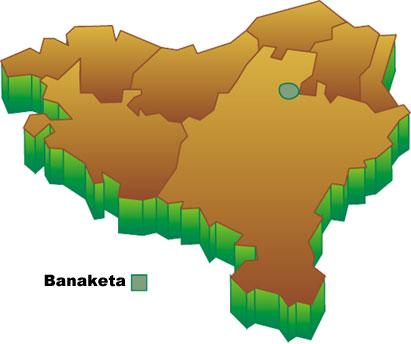
I will not forget the last time I met the gamo. That rainy day I left behind the gloom of the beech and went to a garbigune dotted with ferns. Suddenly, a crude bark broke the silence, while I saw a great shadow move. Two! Three, four, five! After the first, four other animals went out into the forest, sometimes running down, others jumping with all four legs, as if they were docks. Occasionally I could see it appear above the ferns, with an intense white tail at the bottom, very upright. Great show!
Species that have had to flee from predators since their birth on Earth have developed throughout evolution numerous systems not to fall into the clutches of hunters. In the case of Adarzabal, the brown-reddish skin, decorated with white scars, in addition to fascinating, is excellent for camouflage. In addition, in autumn changes fur with a brown or gray leather perfectly adjusted to the dark colors of winter. On the other hand, sound signals such as barking cervids are widespread among animals. Thus, in addition to warning the members of the species of danger, the enemy around him is warned that he has detected it.
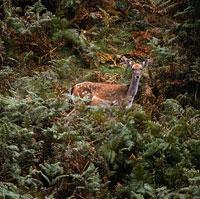
A curious way to lift the tail while fleeing and jump into spring mode can be a way to warn that there is danger. In addition, another reason for the jumps may be that some authors show that the raptor is in good condition. For this reason, the predator who sees it will not waste energy in catching an animal so fast and will not have to flee the gamo.
We cannot forget, of course, the strict senses of this rapid herbivore. It is not easy to find them because they have the ability to smell the man hundreds of meters, see him at night, or hear the rumor between two distant friends.
The scientific name of the lady Lady of Adarzabal reminds me that the upright head and the wonderful skin is an elegant animal that takes them airily as the best. It can reach 130-200 cm in length, weighing 60-125 kg in males and 30-50 kg in females. The tail, which can show upright in the escapes, is long compared to the roe deer, 15-20 cm and black, with white edges. On the other hand, the bottom of the pole and the ribs are grills.
The branches that develop in the males are also special. Unlike deer, they are flat, shaped like shovels. As in the rest of the cervids, they fall every year (by May/April) and start growing then to be ready with velus for August. These spectacular tools of struggle, defense or attraction of females are one more sample of the health of the animal and its form, more than of age. In the best time they can reach 65-78 cm.
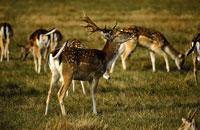
This mammal of the deer family appears in the jungle, in the isolated forest, in the parks. In these scrub forests, alternated by the pastures he likes so much, he moves at night forming groups of females and offspring. Males are more solitary, at least outside the reproductive era.
The heat begins in October and the males fight to form a group of collecting and covering females. During the season of heat the males make a hive of barking. After this reproductive period that lasts until November, during the winter most people will remain in groups until the males start a solitary life in spring.
Between 7 and 8 months later, by May/June, the female performs a breeding and after spending the first few days in a quiet corner, she is ready to follow the group immediately. Although in the first few weeks you drink only breast milk, gradually you feed on the herb until the 6-9 month the mother completely leaves the udder. The child lives with his mother a year or a half.
Gambons are herbivores and complete the diet with fruits and sprouts. In winter, when the snow covers the ground and seeks nothing else, they should try to fill the stomach with the surfaces of the young trees and with which they can.
How is this herbivore divided? The current distribution is very wide. We can find it in parks all over Europe, except in Iceland, northern Scandinavia, Ireland and the Mediterranean islands. Apparently, after the last glaciation, this animal only remained in southern Turkey and Mesopotamia, and later entered all the countries of the Mediterranean by the hand of the Phoenicians, and half and southern Europe, as hunting, of the Romans.
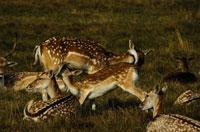
In Euskal Herria, however, there is little. It is only found in the mountains of Quinto Real in Navarra and its number is relatively small. Their animals, introduced together with deer in 1956-57, have not been too successful in their expansion into the new environment. It seems that the gamo has not adapted as well as in other occasions to this region and in the winter snowfall many specimens die every year. The Government of Navarra, aware that these animals did not fit too well, tried to remove them, granting special permits for hunters.
However, a species less adapted to the area is very skilled to escape predators and has not yet managed to eliminate them altogether. You can still hear its particular barking in the mountains around Eugi or see a curious getaway if you had some luck. Silence and care!
Species: Dama dama |

Gai honi buruzko eduki gehiago
Elhuyarrek garatutako teknologia



